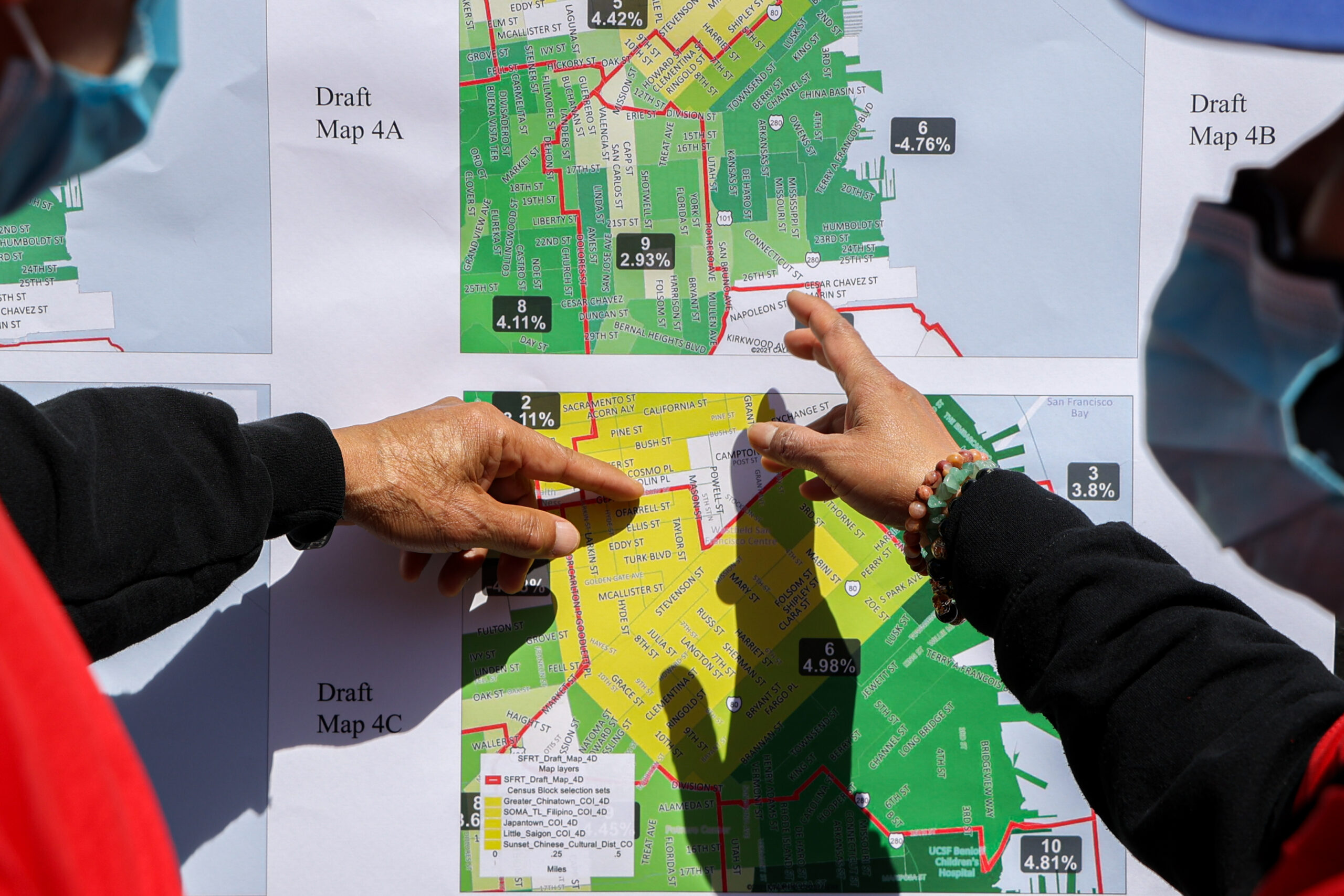A common refrain embraced by people under pressure is “if you’re making people mad, you must be doing something right.” By that measure, San Francisco’s Redistricting Task Force is doing yeoman’s work.
San Francisco is nearing the end of its process of revising supervisorial district lines to reflect population changes in the 2020 census. A nine-member task force—with three members appointed by the mayor, three by the Board of Supervisors and three by the Elections Commission—are evaluating new maps that attempt to rebalance the population of the districts. And they’re taking quite a bit of heat for it, with a slew of political and neighborhood groups now rallying members to flood the task force with demands to use their preferred maps.
A number of community groups, ranging from the Bernal Heights Democratic Club to the League of Women Voters, have disseminated texts, emails, social media posts and even flyers in recent days, rallying their memberships to attend a Wednesday task force meeting that is certain to prove controversial.
Gallery of 2 photos
the slideshow
The task force is charged with the difficult task of drawing new district lines with relatively equal populations, while taking care not to dilute the voting power of communities of interest—people with shared interests, often based on ethnicity or culture, who want to be able to vote on common priorities. A total of 84 communities of interest publicly filed for consideration this cycle, and balancing the two goals has proved especially difficult.
Every district is supposed to have roughly 80,000 people according to the most recent census. But right now, under the current district lines, there’s a serious imbalance: While many districts now have well under 80,000 residents, the population of District 6 has shot up to 104,000 residents. That’s because most of the city’s new housing development has taken place in District 6 neighborhoods, notably SoMa.
This was exemplified by the results of the task force’s most recent meeting on April 4. The meeting extended past 3 AM, when the task force voted to dispense with the map it had been using for their most recent work. Instead, the task force voted to start fresh with another one of the multiple provisional maps drafted by consultants.
Because of the way the maps are labeled, and because the decision to swap working maps took place late into a long meeting, the move angered some stakeholders. Political groups–and even some politicians–cried foul, even accusing the task force of arbitrarily backtracking on its work at a time less accessible to public scrutiny.
District 5 Supervisor Dean Preston, who has been a highly vocal critic of the redistricting process, went so far as to use part of his time at Tuesday’s Board of Supervisors meeting to imply that the task force may have violated open government laws.
“I am shocked and frankly appalled by the task force’s actions,” said Preston in a speech during roll call, when supervisors introduce new legislation or air other concerns. “I am concerned about how these maps came to be, and by the sudden reversal and radical changes to district boundaries that were suddenly proposed…we will need transparency to learn what happened here.”
It’s bizarre to the point of absurdity to say that a district’s population is “getting moved out.” As if it’s mass deportation or evictions. Or maybe I’m underestimating Preston’s cynicism? Is this deliberate? https://t.co/R6mAV3w1YT
— Jason McDaniel (@ValisJason) April 6, 2022
Lily Ho, a member of the redistricting task force, maintained that the body has been transparent in its work, and that its decision to switch from map “4D” to “4B” does not represent any abrupt reversal of earlier work.
“It’s not an earlier map, it’s a different map that has a baseline with population flexibility,” she said in an interview on Wednesday.
Map 4D holds District 6 at the top line of population, with 4.98% variance from the mean population, slightly lower than the 5% legal maximum. She described attempts to equalize the populations on map 4D, but added it was “impossible to keep communities [District 6 and District 3] intact.”
Preston’s comments are part of a concerted display of influence by a number of interest groups across the city. Task force meetings have repeatedly extended into the early hours of the morning due extensive public comment: One meeting, on Saturday April 2, stretched over ten hours.
At least two prominent political groups have developed their own maps: San Francisco Rising, an alliance of progressive grassroots groups, has proffered a “Community Unity Map” for adoption. The Coalition for San Francisco Neighborhoods, an umbrella group of neighborhood organizations, has offered up its own a map, called the “Incremental/Minimal Change Redistricting Plan,” which CSFN consultant Chris Bowman described in an email as “remarkably similar conceptually [to the SF Rising Map] about 80% of the time.”
District 1 resident Bobak Esfandiari, who has been monitoring the proceedings, expressed frustration at seeming redundancies and coordination among the many callers and attendees advocating for changes.
“Many people who are dialing in, who I understand their passion and concerns, [are] advocating for basically no change whatsoever…[or] to almost entirely freeze the current maps and tinker around the edges to just create things which are just barely compliant,” Esfandiari said.
The added attention to the task force comes as it nears its April 15 deadline for submitting an approved map to the Board of Supervisors. More meetings have been announced, to continue from tonight through Wednesday, April 13.
